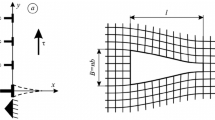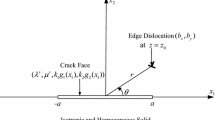Abstract
It has been shown that surface cracks as well as holes can be represented in terms of surface dislocations. These surface dislocations exist in order to insure that no tractions act on any free surface within a stressed body. Using numerical techniques, it is shown that the energy as well as the stress field associated with cracks or holes can be determined. In principle then, any hole or crack problem can be solved to any degree of approximation using the dislocation formulation described herein.
Résumé
On a pu montrer que les fissures de surface, aussi bien que les cavités peuvent être représentés par des dislocations de surface. Celles-ci ont pour rôle d'empêcher que des efforts de traction n'agissent sur une surface libre se trouvant dans un corps sous contraintes. A l'aide des techniques numériques, on montre qu'il est possible de déterminer l'énergie et le champ de contrainte qui sont associés à des fissures ou à des cavités. Dès lors, en principe, tout problème de cavité ou de fissure peut être solutionné à quelque degré d'approximation que ce soit en utilisant la formulation en termes de dislocations qui est décrite dans l'article.
Zusammenfassung
Man zeigt daß Oberflächenrisse sowohl als Löcher in Form von Oberflächendislokationen dargestellt werden können. Diese Oberflächendislokationen bestehen um zu versichern daß an keiner freien Oberfläche eines Körpers unter Spannung, Zugkräfte bestehen. Mittels numerischen Verfahren wird gezeigt daß die Energie sowohl als das durch Risse oder Löcher bedingte Spannungsfeld bestimmt werden können. So kann man dann grundsätzlich irgend ein Loch- oder Rißproblem mit jeglichem Annäherungsgrad lösen indem man das in diesem Bericht beschriebene Dislokationsverfahren anwendet.
Similar content being viewed by others
References
M. J. Marcinkowski and R. W. Armstrong, J. of Appl. Phys., 43 (1972) 2609.
M. J. Marcinkowski and E. S. P. Das, Physica Status Solidi, a8 (1971) 249.
E. S. P. Das and M. J. Marcinkowski, J. of Appl. Phys., 43 (1972) 4425.
J. P. Hirth and J. Lothe, Theory of Dislocations (1968) published by McGraw-Hill Book Company, New York.
A. H. Cottrell, Dislocations and Plastic Flow in Crystals, Oxford, The Clarendon Press, London (1958).
B. A. Bilby, Report of the Conference of Defect in Crystalline Solids published by The Physical Society, London, 124 (1958).
R. Bullough and B. A. Bilby, Proceedings of The Physical Society of London, B69 (1956) 1276.
M. J. Marcinkowski, Advances in Materials Research edited by H. Herman, Vol. 5 (1971) 443 published by Wiley-Interscience, New York.
R. A. Sack, Proc. Phys. Soc. (London), 58B (1846) 729.
J. S. Koehler, Phys. Rev., 60 (1941) 397.
J. Weertman, Bulletin of The Seismological Society of America, 54 (1964) 1035.
M. J. Marcinkowski, Electron Microscopy and Structure of Materials, edited by G. ThomasR. M. Fulrath and R. M. Fisher 382 (1972) published by The University of California Press, Berkeley, California.
Author information
Authors and Affiliations
Additional information
The present research effort was made available through a grant from The Materials Research Laboratory Section of The National Science Foundation, the Advanced Research Projects Agency (ARPA) through the Center of Materials Research of The University of Maryland, and the U.S. Atomic Energy Commission.
Rights and permissions
About this article
Cite this article
Marcinkowski, M.J., Das, E.S.P. The relationship between cracks, holes and surface dislocations. Int J Fract 10, 181–200 (1974). https://doi.org/10.1007/BF00113925
Received:
Revised:
Issue Date:
DOI: https://doi.org/10.1007/BF00113925




